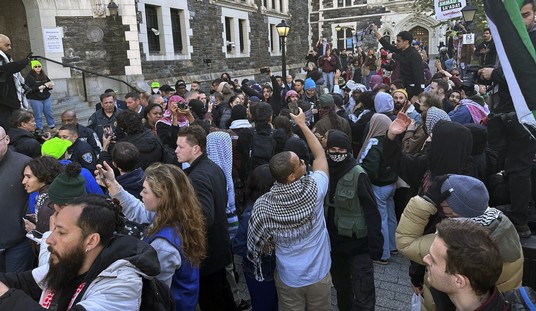This formulation is wearing thin, but the "good news" is the US unemployment rate fell to 8.1 percent last month. The bad news is that the U3 figure dropped for all the wrong reasons, and other crucial indicators looked decidedly gloomy -- again:
Nonfarm payroll employment rose by 115,000 in April, and the unemployment rate was little changed at 8.1 percent, the U.S. Bureau of Labor Statistics reported today. Employment increased in professional and business services, retail trade, and health care, but declined in transportation and warehousing. Both the number of unemployed persons (12.5 million) and the unemployment rate (8.1 percent) changed little in April. (See table A-1.) ... The civilian labor force participation rate declined in April to 63.6 percent, while the employment-population ratio, at 58.4 percent, changed little.
As Ed Morrissey points out, that workforce participation rate represents a new three-decade low, and that much of the plunge has occurred during the so-called "Obama recovery:"

CNBC adds more context to this graph:
Overall the report painted a picture of a jobs market that had gotten a boost from unseasonably warm winter weather but now has cooled. Though the headline number indicated job creation, the total employment level for the month actually fell 169,000. The disparity likely emanates from a drop in the labor force participation rate — or the level of Americans actively looking for jobs or otherwise employed — from 63.8 percent to 63.6 percent, its lowest level since December 1981. The amount of discouraged workers swelled from 865,000 to 968,000, an increase of 12 percent. Those working part-time for economic reasons surged 181,000 to more than 7.8 million. "In the weakest recovery since the Great Depression, more than four-fifths of the reduction in unemployment has been accomplished by a dropping adult labor force participation rate — essentially persuading adults they don't need a job, or the job they could find is not worth having," said University of Maryland economist Peter Morici.
In short, overall employment fell, the number of Americans abandoing the workforce altogether surged by 12 percent, and even more Americans shifted to part-time work out of economic necessity. Economic stats guru Zero Hedge notes that more than half-a-million US workers left the labor force last month -- a number that dwarfs the official "jobs added" total. President Obama often reminds us that he inherited the worst recession since the Great Depression. His failed policies have, in turn, precipitated the weakest recovery since at least the 1930s, plunging us much deeper into debt with very little bang for our borrowed buck. No wonder the Obama campaign is desperate to manufacture wars on women, students, oil speculators, etc -- anything to avert voters' gaze from these awful numbers.
Recommended
UPDATE - Jim Geraghty strolls down memory lane:
November 2006: “Pelosi was not to be outdone, however, firing back at the president who she claimed had “the worst jobs record since the Great Depression,” in spite of Friday’s news that the October jobless rate fell to 4.4 percent, the lowest it has been in more than five years.”
TWS' Jay Cost opines that Obama's re-election "fundamentals" remain quite weak, which may help explain Mitt Romney's swing state resurgence.


